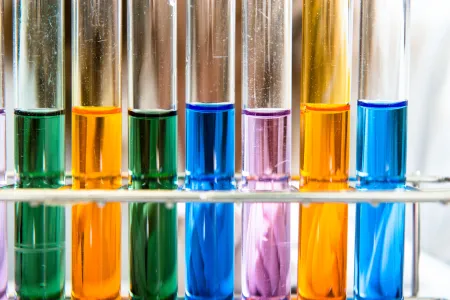
Chemistry
Splitting disulphide bonds in water is more complicated than assumed
In proteins and rubber, they are indispensable: bonds between two sulphur atoms that link long molecules together. Pulling from outside on the disulphide bonds triggers unexpectedly complicated processes.
From a chemical perspective, splitting disulphide bonds under tensile stress is a substantially more complicated process than previously assumed. A team headed by Prof Dr Dominik Marx from Ruhr-Universität Bochum found out what happens in detail during this process – with the aid of extensive computer simulations on the Jülich supercomputer “Juqueen”. The researchers report their results in the journal “Nature Chemistry”.
Depending on the strength of the pull exerted on the bond between the two sulphur atoms, the reaction mechanism that splits the bond is changed. “That was previously unknown, and it especially makes a correct interpretation of experimental data much more complicated than thought,” says Dominik Marx.
Disulphide bonds under stress
Disulphide bonds occur, for instance, in proteins. They keep them in particular structural arrangements, and also serve as a switch for biological processes. If they are located in an alkaline aqueous solution and it is heated, the following chemical reaction is started: A hydroxide ion (OH-) attacks the disulphide bond, forms a new bond with one of the sulphur atoms, and thus splits the bond. Scientists call this mechanism alkaline hydrolysis in water.
The researchers in Bochum investigated what happens, when the sulphur bond is also placed under tensile stress. They did a computer simulation of a corresponding molecule in aqueous solution and virtually pulled on both ends of the bond. “Such mechanochemical processes actually occur for small forces in cells, or they are used in order to recycle old rubber,” explains Marx.
Role of water decisive
In simulating these processes, it was decisive that the role of the surrounding water be taken into consideration correctly. The hydroxide ion that attacks the disulphide bond is surrounded by a coating of water molecules, which changes in a complex manner during the course of the attack.
Usually theoreticians use methods that drastically simplify the effects of the surrounding water, in order to reduce the required computational effort. In order to simulate the processes realistically, however, the water must be computed quantum mechanically, just like all the other molecules. Only then does the simulation provide the correct energy flow of the reaction in the aqueous solution.
Immense computational effort
The key for success were especially extensive computer simulations, so-called ab-initio molecular dynamic simulations. “They do require an immense computational effort,” explains Marx. It was managed by one of Europe’s fastest computers – the IBM Blue Gene/Q computer “Juqueen” at the Jülich Supercomputing Centre at the Jülich Research Centre. The calculations were made possible through a major project of the Gauss Centre for Supercomputing.
Brutal physics victorious over subtle chemistry
“Although complex chemical processes occur as the tensile stress increases, something quite simple happens at maximum force,” explains Dominik Marx. If a firm pull – for example a force of two nanonewtons – is exerted on the bond, the alkaline hydrolysis of the sulphur-sulphur bond no longer occurs. Instead, the bond between one of the sulphur atoms and a neighbouring carbon atom simply breaks. Or, as Marx summarises in somewhat of an overstatement: “When raw force rules, brutal physics defeats subtle chemistry.”
